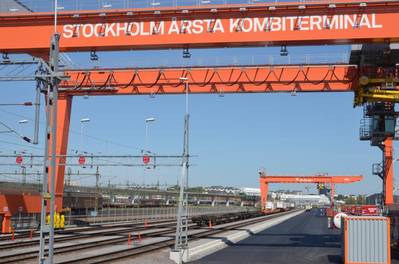The EU funded EcoHubs R&D project (Environmentally COherent measures and interventions to debottleneck HUBS of the multimodal network favored by seamless flow of goods) has delivered a number of ICT tools which can increase capacity at ports and terminals, and can lead to reductions in carbon footprint.
Designed to support “Resource Efficient Europe”, the flagship initiative of the Europe 2020 Strategy, EcoHubs has, for the last 30 months, researched and developed the tools required for sustainable freight transport and logistics networks as part of a smart, safe, environmentally friendly and inclusive EU economy.
Adria Kombi, a combined transport operator in Slovenia is deploying the CCIS (Container Interfacing and Consolidation System) tool in conjunction with the ecoTAURuS (Ecohubs Truck Appointment & Unit Reporting Status Services) system at the Port of Koper and estimates that when fully implemented, this will lead to a 20 percent increase in capacity. This increase requires no additional physical infrastructure investment and an improvement of throughput by 15 percent, equating to a 1.6 – 2.3 Million Euros in turnover can be realized.
As part of its efforts to provide a complete CO2 footprint measuring system which can calculate and declare the energy consumption and GHG emissions of transport services, EcoHubs also developed the ITEC (Intermodal Terminal Eco-Efficiency Calculator) tool.
This tool bridges the knowledge gap of other CO2 calculators such as EcoTransit and standards including CEN 16258 which do not consider the warehousing and transhipment facilities.
To demonstrate the robustness and effectiveness of the ITEC tool, Jernhusen in Stockholm had the opportunity to obtain a measurement of the CO2 footprint of Stockholm Årsta Kombiterminal, the Green Urban Hub, before and after the transformation of the terminal. The data highlighted that Jernhusen has reduced the footprint by more than half, 56%. On an annual basis, this equates to approximately 55 car trips around the Earth.
The project has also developed: Transport & Terminal Services Publisher (T2SP) for the dynamic and unified publishing/discovery/updating of detailed terminal services; Proximity Network Management (PNM) which enables the collaboration among terminals and is being deployed at Interporto Bologna; Repair Services Publisher (RSP), to share equipment for improved wagon repair services and MetricHub a system for capturing, calculating and sharing metrics which allows customers to drive continuous improvement among collaborative networks.

















